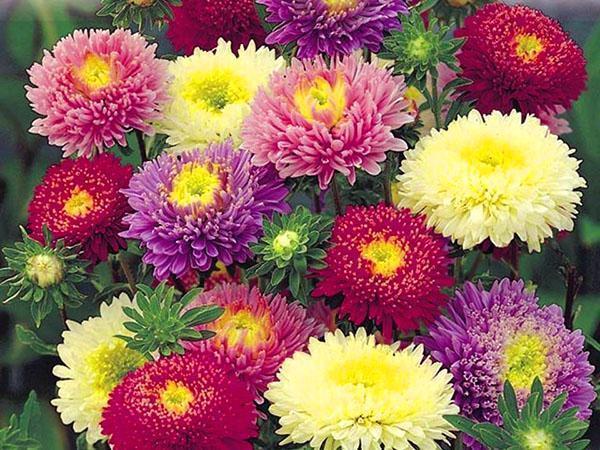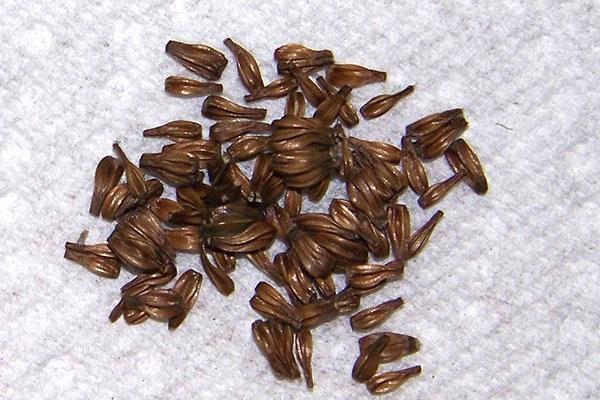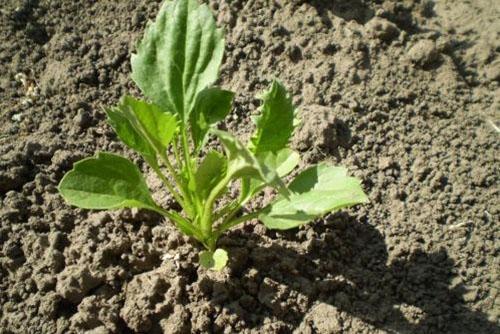When to plant asters for seedlings
 Astra is an autumn beauty that conquers everyone. It is not surprising that with the arrival of spring, many gardeners are wondering how to properly sow aster seeds for seedlings, when to plant and at what time to transplant into the ground.
Astra is an autumn beauty that conquers everyone. It is not surprising that with the arrival of spring, many gardeners are wondering how to properly sow aster seeds for seedlings, when to plant and at what time to transplant into the ground.
Scientifically, a plant growing in all personal plots and gardens is called kalistemma. According to legend, at the beginning of the 16th century, a French monk brought the seeds of this beautiful plant to Europe from China. There are many varieties of asters, both annuals and perennial asters, most of which can be grown in different climatic zones.
How to choose the right seeds for seedlings

This takes into account such parameters as the appearance and height of the bush, the structure and shape of the inflorescences (ordinary or double), what type of branching the plant has, the color, the shape of the petals (needle-like or ordinary), and so on. As a rule, manufacturers indicate all characteristics on the packaging.
In addition, you should pay attention to the date of collection of seeds. The longer the period, the worse the germination. So it is preferable to buy last year's "harvest".
Sowing seeds
Most often, asters are planted for seedlings in boxes, but you can immediately into the soil.
Sowing in open ground
 Planting is carried out as soon as the soil warms up (as a rule, this is the beginning of May) to a depth of 0.5-0.8 cm, having previously prepared the seeds (they must be soaked in a germination accelerator). After 2 weeks, shoots appear.
Planting is carried out as soon as the soil warms up (as a rule, this is the beginning of May) to a depth of 0.5-0.8 cm, having previously prepared the seeds (they must be soaked in a germination accelerator). After 2 weeks, shoots appear.
When 2-3 leaves are formed on the stem, thinning of the seedlings is carried out, observing the distance between the plants of 10-15 cm. Seeds can be planted in the frozen ground in late autumn (it is pre-prepared), then sprinkled with dry soil. You can also plant seeds in December-January, placing them in the grooves and sprinkling with a mixture peat with dry ground, and above - with snow. Of course, they do this in the absence of severe frosts.
As you grow, you should take care of the young by:
- Loosening the soil 4-6 cm deep after rain or watering.
- Hilling 5-7 cm above the ground until branching begins.
- Moderate watering (in the heat it should be plentiful, about 3 buckets per 1 m2).
- Water stagnation control.
- Nutrition, as a rule, three times: 10-15 days after thinning, the appearance of buds and at the beginning of flowering.
Sowing for seedlings
 The instructions always indicate the time of planting seeds in the ground. But gardeners do not recommend resorting to this method due to the onset of late flowering and advise to sow asters for seedlings (usually March-April), and later plant the young in the ground.
The instructions always indicate the time of planting seeds in the ground. But gardeners do not recommend resorting to this method due to the onset of late flowering and advise to sow asters for seedlings (usually March-April), and later plant the young in the ground.
As in the case of planting in open ground, the seeds should be soaked in an accelerator. Asters are sown in containers with a substrate for seedlings when the end of March - early April comes to a depth of 0.5-0.8 cm, covered with earth and then covered with a film.
 The substrate can be used purchased or made independently by mixing humus, garden soil and sand. Do not forget to disinfect with phytosporin or potassium permanganate. You can bring the acidity to normal values with ash. The ideal temperature for germination is 18-25 ° C. Shoots appear in a week, and after another 10 days, leaves are formed. During this period, asters are picked into separate cups.
The substrate can be used purchased or made independently by mixing humus, garden soil and sand. Do not forget to disinfect with phytosporin or potassium permanganate. You can bring the acidity to normal values with ash. The ideal temperature for germination is 18-25 ° C. Shoots appear in a week, and after another 10 days, leaves are formed. During this period, asters are picked into separate cups.
At the time of seedling growth, good lighting should be provided (preferably southern and southwestern windows), regular watering (in the morning) and a temperature of 16-25 ° C in the daytime and 12-15 ° C at night.
1-2 weeks after the dive, you can feed with special fertilizers for seedlings. You can use the mixture superphosphate and saltpeter in a ratio of 15:20 g for every 10 liters of water. By the time of planting, 2-3 additional fertilizing should be carried out, alternating spraying with fertilizers with root watering.
When 4-5 leaves appear, the seedlings periodically begin to be taken out onto the glazed balcony so that it hardens, and then into the fresh air and sun, starting from 15 minutes with a gradual increase in time.
Planting seedlings in the ground
 Asters sown earlier for seedlings are planted in the ground when 50 days have passed. In this case, the height of the young stock should be 6 cm and there should be at least 5 leaves on each stem. Disembarkation is carried out according to the weather. As a rule, gardeners are guided by the popular omen, according to which the end of the flowering of bird cherry indicates the absence of frost in the future.
Asters sown earlier for seedlings are planted in the ground when 50 days have passed. In this case, the height of the young stock should be 6 cm and there should be at least 5 leaves on each stem. Disembarkation is carried out according to the weather. As a rule, gardeners are guided by the popular omen, according to which the end of the flowering of bird cherry indicates the absence of frost in the future.
Choice of location
 Decide on the location of the flower bed should be in the fall. For long blooming, it is best to place it on the sunny side. If there is no suitable place, you can set up a flower garden in partial shade.
Decide on the location of the flower bed should be in the fall. For long blooming, it is best to place it on the sunny side. If there is no suitable place, you can set up a flower garden in partial shade.
Aster has no special requirements for the soil, except that it should be of normal pH, light and good for air permeability.
The only requirement is not to plant aster seedlings grown at home, as well as seeds in the ground, where levkoi, tomatoes, gladioli, carnations, and potatoes grew before.
In the fall, 2 kg of sand are preliminarily introduced into the soil, ½ a bucket of humus per 1 m2 and dig up. In the spring, ammonium sulfate, superphosphate, potassium salt are scattered in 1 tbsp. l. each for 1 m2.
How to plant seedlings correctly
 First of all, the plants are well watered and left for 30 minutes so that they can be easily removed from the cups. The transplant is done with a "native" lump of earth in a previously prepared soil or dug holes (not forgetting to water well) to a depth of no more than 20 cm, since the root system of asters is located close to the earth's surface.
First of all, the plants are well watered and left for 30 minutes so that they can be easily removed from the cups. The transplant is done with a "native" lump of earth in a previously prepared soil or dug holes (not forgetting to water well) to a depth of no more than 20 cm, since the root system of asters is located close to the earth's surface.
When planting, keep the distance between plants. It should be at least 20 cm. This ensures good development of the asters.
It is best to plant grown seedlings of asters in the ground when the weather is cloudy outside. So the plants will recover faster. In clear weather, the procedure should be carried out in the evening. After planting, the plants are well watered with water, trying not to get on the foliage. Further care is carried out similarly to the method of planting seeds in open ground.